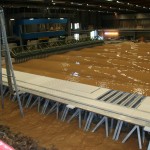
Hydrological experiment basin at Deltares in Delft, The Netherlands...Photo by Lt. Shawn Baldy
In just 24 hours, our latest video uploaded to YouTube garnered 19 honors including #1 most viewed and #9 most discussed.
The 6-minute documentary was created with footage captured by an Amsterdam-based film crew commissioned by Levees.org while H.J. Bosworth Jr. and Sandy Rosenthal were in Holland with US Senator Mary Landrieu’s Second Congressional Delegation (CoDel) excursion.
Unlike the first CoDel which studied peripheral barriers (floodgates), the goal of this CoDel in May was to see how the Dutch live with, and manage water in urban settings.
UPDATE: Environmental Defense has done a write-up of Levees.org’s trip to Holland and included it along with a link to our video on its national newsletter called Delta Dispatches.
UDATE: This video was #14 top viewed this week. (Sept 6, 2009)





“Yes We Can” should be “Yes We Do!”
Great video!
The video is excellent indeed. I was amazed at the precision of the capacity to manage the water levels in the day to day.
The levels of the water are managed very close to the top of the land with it appears a great deal of confidence in those levels of close tolerances.
Clearly this video and the practice of the Dutch reveals even more powerfully why the
.”.let’s get the backhoes and find some more clay somewhere et al methods” of the US Corps of Engineers are at this point in the technology of water management nothing less than “neanderthal”.
Moreover the Corps of Engineers is also way behind by many years regarding the world wide use of additional or in some cases primary use of bioengineering compontents used everywhere but here!
Go to http://www.vertivert.org
Vetivert…ironically a grass that has grown here for at least 200 years and which shares genetic mirroring of much of the vetivert found around the world and used for flood and erosion mitigation as well as land mass and marsh reconstitution and which through research has as well been moved to more and more tolerances re salinity is not even known by them…
And the LSU extension service as far as I can find…last did research in the 80s…Things have moved so far beyond that time…
I urge everyone to research and read about this powerful mitigation and its uses esp in Australia…I have done so for years..
Thanks Sandy and Mr. Bosworth for your excellent film here!.and of course all of your work!
We Can and We DO..oh would someone please remind Pres Obama that in his recent TP interview..he continues to cite what happened after Katrina as a “natural diseaster”…I
So sorry..typo on the link
http://www.vetiver.org
Oh and when you do go to the Vetiver International site..do note that on the very front opening page…they cite Vetiver
Sunshine cultiver as recently(only recently ..got that?)being approved by USDA et al for use for some of the very issues I cite above.
The name Sunshine cultiver…where did that come from…Hold on…right over in Sunshine La…right across the lake..yep that’s right…
Go look at the root system on this grass and its characteristics…go read everything you can about it on this site..
and then..tell me? Why No Vetiver anywhere
in their plans anywhere?
Could it be that it costs so little that trained volunteers have planted it all over the world effectively…could it be that the rock and concrete steel people..contractors…just do not like that?
According to a survey on this site of
entities using vetiver…this objection served as one of the top three reasons why in their countries they had to work long and hard and fight to use the vetiver
Well…you decide after you read this site thoroughly..It will take a while .There is a lot there and a lot more coming.
The following citation comes from the http://www.vetiver.org site I mentioned above…”Sunshine” vetiver is a traditional, non-fertile Louisiana cultivar (variety) that was introduced to the Gulf region in the
French colonial era over 200 years ago. In principle, non-native plants intended for use in environmental protection or
agriculture must be investigated for their potential to become weeds or to act as intermediate hosts for pests that affect
economically important crops. Sunshine vetiver was officially released from observation by the USDA Golden Meadows
Plant Material Center, in Louisiana in 1995. Refer to http://plant-materials.nrcs.usda.gov/lapmc/releases.html The South
Eastern Exotic Pest Plant Council, declared in May 2001 that Sunshine vetiver is acceptable for use in the region. Refer
to: http://www.se-eppc.org/fslist.cfm. More recently, the Pacific Island Ecosystem at Risk (PIER) Project carried out a risk
assessment of non-fertile vetiver grass cultivars from South India (Sunshine, US and Monto, Australia). A rating of +1
means that the plant species is “low risk” for invasiveness. Vetiver grass was rated negative eight (-8). The very low risk
rating is based on the Australia/New Zealand weed risk assessment protocol, modified for Hawaii by the USDA and
other cooperators. The link to the PIER risk assessment for vetiver grass is: http://www.vetiver.org/USA_PIER.h…”
1995? and USDA used the low risk invasion rating used in Australia..which has been using this plant for some time…
So what do you think the issue about ole Vetiver has been? Huh?
ANd just one more comment
Instead of cutting down the trees along the grass mound levees in Lakeview and into Jefferson parish..especially of native species..you know roots and all ..the old ..hold the soil idea..The Corps should have left the trees and planted vetiver hedges below the trees…with the singular capacity not only to embed straight down into varied kinds of soil to 6-9 feet…see photos on site of root system..but with the capacity to save in wash back around the vetiver stalks any soil eroding from above…
Did they do that? How many bioengineers are within the Corps of Engineers stable of Engineers?
Ok…I am finished…Cheers…